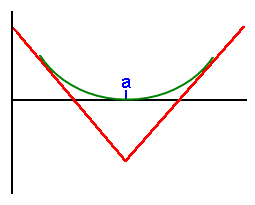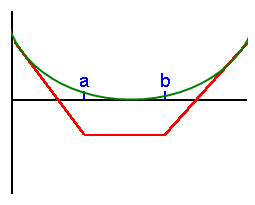
Hedging: Capturing Volatility with Straddles and Strangles
One of the most powerful advantages that options bring to directional traders is the limited risk associated with long options. If you are bullish, you can buy a call; if you are wrong, the most you can lose is the cost of your call (including transaction fees). Similarly, for bearish trades, put purchases allow you to profit from a selloff, but limits the loss if it does not happen.
But what if you think that the market is poised to make a big move, but you’re not sure which way? If you are a spot only trader, you have to wait: you cannot be long and short at the same time. However, by buying both a call and put, you can in effect be both long and short at the same time. This strategy is called a straddle, and this is the payoff diagram:

For this trade, the current market price is at point a, and you buy a call option and a put option with the same expiration and the same strike price (which is also at or near point a). The trade will immediately profit with any movement away from point a – either lower or higher – provided the volatility of the options does not change.
A straddle is a good strategy when you expect some event to affect the market dramatically, but you don’t necessarily know if it will be bullish or bearish. Examples include economic reports, elections, congressional votes, weather, and geo-political events.
So how can this go wrong? Notice the red v-shaped curved. That is the profit and loss on the expiration day of the options. The upper p/l curve (green) will slowly “creep” down as time passes. This is known as time decay. If the market does not move away from point a quickly enough, the trade will suffer. Sometimes this happens little by little. Traders sometime refer to this as “bleeding time decay”.
Unfortunately, the times when straddles are attractive are also the time when options may be expensive; implied volatility may be high. One way to control the cost of initializing this trade is to buy a strangle instead of a straddle. A strangle is also composed of a long call and a long put, but with different strikes. The put’s strike is below the market and the call’s strike is above the market. Here is a payoff diagram for a strangle:

For this trade the current market price is somewhere between point a and point b. The put has a strike price of a and the call has a strike price of b. As with the straddle, the trade makes money as the market moves toward a or b, and time decay will pull the p/l curve lower toward option expiration.
For either one of these trades, it is important to create a plan and stick to it. If the market in fact makes a move and the trade profits, you should decide when you will liquidate. Time decay will eventually take its toll.
Capturing Volatility with Dynamic Delta Hedging
Long straddle and long strangle strategies offer the opportunity to take advantage of a volatile market by buying both a call option and a put option simultaneously. If the spot market makes a significant enough move, these strategies profit because the gain on one side (call or put) more than offsets the loss incurred on the other side. See “Capturing Volatility with Straddles and Strangles”.
Is it not always obvious, however, when to take profits in this trade. If the spot price moves higher, the call option will profit and the put option will suffer. In addition, the deltas of both options will increase (the delta of the put option will get less negative). This turns the strategy into a bullish one. If, on the other hand, the spot market were to initially move lower, both options would lose deltas and the strategy would become bearish. The reason for this is that long options have positive gammas: bullish positions get more bullish and bearish positions get more bearish as they earn profits from spot price movement.
Once a straddle or strangle trade is showing a profit, it will also, therefore, be showing some delta (directional) risk. One easy way to avoid this risk is to liquidate the trade, take profits, and move on. Before executing this (or any other) strategy, you should set a profit target and maximum risk level. You should then stick to the trade plan and liquidate according to the goals, no matter what the market conditions are.
However, what if you think that the spot market will continue to be volatile after it is already time to close out the trade? If the trade has met its goal, the obvious solution is to liquidate it and buy another at-the-money straddle or strangle. There is another trading method, however, that allows you to keep the current trade and adjust it with a spot position in order to alleviate the delta risk. It is called Dynamic Delta Hedging, also known as Gamma Scalping.
The method involves buying multiple straddles or strangles, monitoring the deltas on both the calls and puts, and then buying or selling spot positions so that the overall delta is brought back to near zero. This effectively creates a new trade that will again profit from another significant move in either direction. You can hedge the trade repeatedly when the spot price moves enough, locking in profits with every hedge.
Example
Spot market is at 1.00. We buy 10 1.00 calls and 10 1.00 puts with 30 days to expiration (any expiration will do, but options with long expirations have smaller gammas making a larger spot move necessary to make the strategy work).
Initially, the trade has a net delta close to zero as the calls will each have a delta near 0.50 and the puts will each have a delta near -0.50.
Suppose, after one week, the spot market has moved to 1.05, and the trade is showing a profit. The call delta has moved to 0.60 and the put delta has moved to -0.40. The overall delta for the position is now 10*0.60 + 10*(-.40) = 6 – 4 = 2. With a net delta of 2.0, the straddle is now a bullish trade; over the short term, it will make and lose money at the same rate as a position composed of 2 long spot contracts.
To hedge the trade, you sell 2 spot contracts and bring the overall delta of the spot + straddle position back to zero. The trade now acts like a “new” straddle and will profit if the market continues higher or falls back toward the original level.
If the market continues higher, the gamma of the position will decrease, especially as option expiration approaches. This means it will take a larger and larger spot market movement to create the same kind of profits. When this happens, it is best to liquidate the entire position and “start over” if you still feel that the market will continue to exhibit high volatility.
Note that long straddles and strangles are long premium – whether they are hedged or not – and will suffer from time decay. These trades will also suffer if the market becomes stagnant. You need to have discipline to exit the trade at a small loss if is not working.